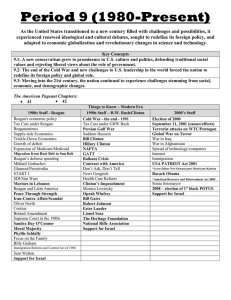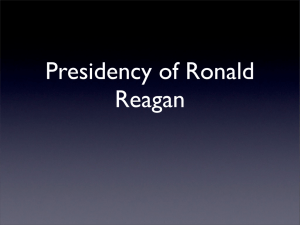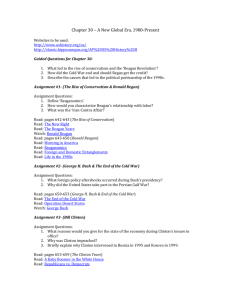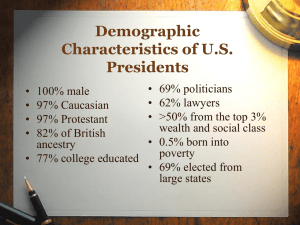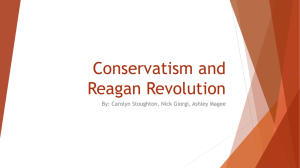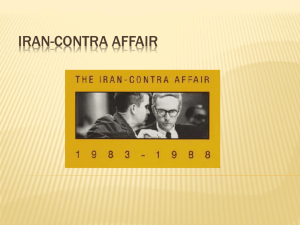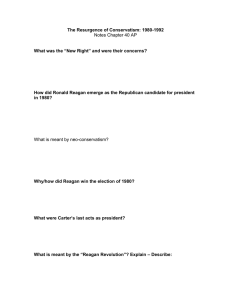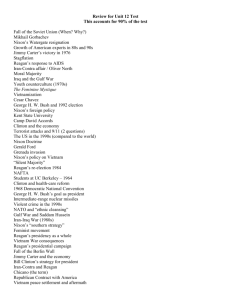Neocon Notes
advertisement
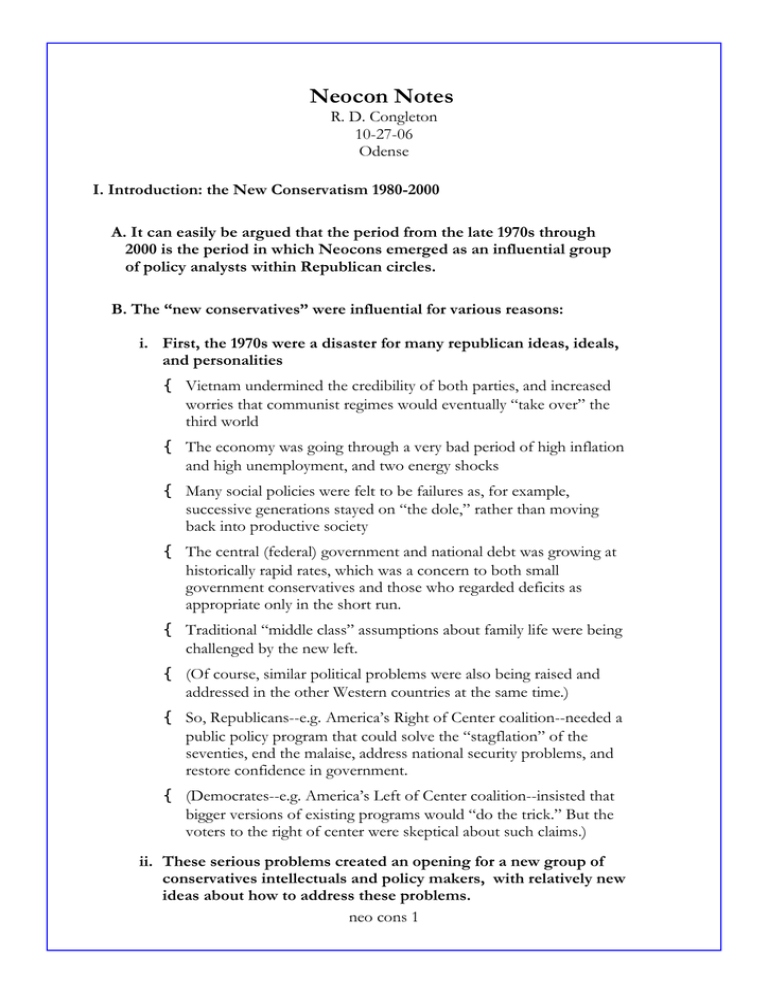
Neocon Notes
R. D. Congleton
10-27-06
Odense
I. Introduction: the New Conservatism 1980-2000
A. It can easily be argued that the period from the late 1970s through
2000 is the period in which Neocons emerged as an influential group
of policy analysts within Republican circles.
B. The “new conservatives” were influential for various reasons:
i. First, the 1970s were a disaster for many republican ideas, ideals,
and personalities
{ Vietnam undermined the credibility of both parties, and increased
worries that communist regimes would eventually “take over” the
third world
{ The economy was going through a very bad period of high inflation
and high unemployment, and two energy shocks
{ Many social policies were felt to be failures as, for example,
successive generations stayed on “the dole,” rather than moving
back into productive society
{ The central (federal) government and national debt was growing at
historically rapid rates, which was a concern to both small
government conservatives and those who regarded deficits as
appropriate only in the short run.
{ Traditional “middle class” assumptions about family life were being
challenged by the new left.
{ (Of course, similar political problems were also being raised and
addressed in the other Western countries at the same time.)
{ So, Republicans--e.g. America’s Right of Center coalition--needed a
public policy program that could solve the “stagflation” of the
seventies, end the malaise, address national security problems, and
restore confidence in government.
{ (Democrates--e.g. America’s Left of Center coalition--insisted that
bigger versions of existing programs would “do the trick.” But the
voters to the right of center were skeptical about such claims.)
ii. These serious problems created an opening for a new group of
conservatives intellectuals and policy makers, with relatively new
ideas about how to address these problems.
neo cons 1
iii. Initially, many of the new ideas for domestic policies came from
right of center academic economists and other policy analysts
that held positions at new right of center think tanks founded in
the 1970s
{ Noteworthy among these were the American Enterprise Institute
(actually founded in 1943) and the Heritage Foundation (founded in
1973).
{ For example, Ronald Reagan said of the AEI in 1988: “The American
Enterprise Institute stands at the center of a revolution in ideas of which
I, too, have been a part. AEI's remarkably distinguished body of work is
testimony to the triumph of the think tank. For today the most important
American scholarship comes out of our think tanks – and none has been
more influential than the American Enterprise Institute.”
{ The think tank was not a “new invention,” but right of center
foundations, some also quite new, gave right of center think tanks
the resources to attract articulate younger talent with new ideas as
well as older established people with government experience.
{ There were important problems to be solved.
{ (Note all of these new right of center think tanks were “neo-con”
policy groups. For example, the Cato foundation established a new
“moderate” and increasingly respectable form of “libertarian” policy
research.)
iv. The American neocons, through the electoral successes of
republicans such as Ronald Reagan (and the many Republican
Senators who won control of the US Senate) were able to adopt
policies that solved many of these problems (most notably
inflation, tax preferences, and malaise) and reduced others.
{ The 1980 election produced a fairly major shift in policies in the US
in the liberal direction (in its 19th century or European sense).
II. The Reagan Revolution (1981-89)
A. In 1980 Reagan defeated incumbent Carter with 51% of the popular
vote, to Carter’s 41.1 % and Anderson’s (6.6%) and the Libertarian’s
(1.1%).
i. (See, for example,
http://www.census.gov/prod/2001pubs/statab/sec08.pdf for
detailed presidential election data.)
ii. It was the first loss by an incumbent since Herbert Hoover in
1932.
neo cons 2
iii. Equally striking was the success of the Republicans in the
Senate, which shifted to the republicans for the first time in
decades.
iv.
Year
1,971
Party of Pres
R
House
d254 / r180
Senate
d54 / r44
1,973
R
d239 / r192
d56 / r42
1,975
R
d291 / r144
d60 / r37
1,977
D
d292 / r143
d61 / r38
1,979
D
d276 / r192
d58 / r41
1,981
R
d243 / r192
d46 / r53
1,983
R
d269 / r165
d46 / r54
1,985
R
d252 / r182
d47 / r53
1,987
R
d258 / r177
d55 / r45
1,989
R
d259 / r174
d55 / r 45
1,991
R
d267 / r167
d56 / r44
1,993
D
d258 / r176
d57 / r43
1,995
D
d204 / r230
d48 / r52
1,997
D
d207 / r226
d45 / r55
1,999
D
d212 / r222
d45 / r54
US Statistical Abstract 2000, table 460
B. The Reagan Revolution
C. Although the neocons are some times described in extreme terms by
their critics (and rivals) on the left, in fact, neocons gained significant
influence in the Republic party because they were not radical, but
shifted the republic party back towards what might be called 19th
century liberalism.
{ [I use the term “liberal” here and throughout these notes in its
nineteenth century sense, which is still the usual meaning of the
term “liberal” in Europe, e.g. as a group emphasizing economic and
civil liberty.]
i. The republican party has nearly always been a coalition of what
in Europe would be called conservatives, liberals, and Christian
democrats.
neo cons 3
ii. Under the Reagan neocons, the republican platform (manifesto)
moved from “mainstream” conservative toward somewhat
“mainstream” liberals.
{ Under the Reagan neocons, the party emphasized open (more or
less) unregulated markets, “economic liberty,” the work ethic, and a
theory of distribution that rests on what economists would refer to
as “marginal value product.”
{ It was a secular program rather than a religious resurgence. The
latter would emerge ten to fifteen years later, partly through the
realignment of the Western and Southern representatives in
Congress.
{ (The realignment under Bush II twenty years later could be regarded
as a move toward traditionalists away from economic liberals, or, in
the European lexicon, a shift toward Christian democrats and
conservatives, away from liberals.)
iii. Regarding tax policies, the neocons favored flatter and broader
taxes as recommended by nearly all public finance economists at
the time.
iv. Regarding inflation, the neocons favored better more predictable
control of the money supply (as long recommended by Nobel
prize economist Milton Friedman) rather than the previous focus
of central banks on nominal interest rates and unemployment.
v. Internationally, the neocons claimed to support liberal democracy
against dictatorships and especially against communist
dictatorships, and many advocated a relatively aggressive
program to challenge (soviet sponsored) communist efforts round
the world.
{ Many favored a balanced budget amendment as an institutional
solution to two decades of significant deficits (including the 1986
Nobel prize winner in economics, James M. Buchanan).
{ Many were “supply siders” who believed that changes in the tax
code, specifically reductions in loopholes and lower marginal tax
rates, would increase economic growth. (The Laffer curve.)
{ (It bears noting that most economists believed that lowering
marginal tax rates would increase economic output. “Supply siders”
were simply more optimistic about the extent to which economic
output would increase than most economists.)
vi. As common in political debates, the critics often make the
Reagan reforms seem more radical (as did the Republican party’s
own rhetoric) than they really were.
neo cons 4
{ Much of the economic deregulation of the Reagan administration,
simply continued and finished policies already in place under Ford
and/or Carter.
{ Much of the foreign policy similarly followed themes that had been
established by Carter and Ford.
{ Many other reforms largely followed long-standing patterns, as with
the social security reforms of 1983 (recommended by the
Greenspan commission) which increased taxes, extended the social
security tax base and slightly reduced future benefit levels by
increasing retirement ages.
[We are very likely to similar reforms adopted throughout the west in
the near future.]
{ Indeed, many of the neocons were ex-democrats who left that party
as its center of gravity moved to the left during the sixties, seventies
and early eighties.
{ (In effect, such neocons were “Johnson” democrats: believers in a
muscular foreign policy and efficient expansive domestic programs.)
vii. There were, however, significant reforms of tax, monetary, and
defense policies during Reagan’s first term of office.
{ Consistent with the administration’s declared international agenda, a
significant build up of the military was undertaken (which was
mostly debt financed).
{ Moreover, with the aid of the Senate and moderate democrats in the
House, a major tax reform was introduced that flattened the tax
schedule and lowering both average and marginal tax rates (and
thereby, together with the increase in defense expenditures, created
significant deficits).
{ Inflation was brought under control by reducing the growth rate of
the money supply--albeit with a recession, although a much milder
one than most Keynesian economists predicted.
{ (The tax reform and the new monetary policy were widely imitated
throughout the west.)
{ Indeed for right of center intellectuals and policy “wonks,” the first
term of the Reagan administration was the “Camelot” that
Kennedy’s first years had been for left of center intellectuals in the
1960s.
[To see evidence of this, simply Google “Reagan legacy,” or “Reagan
Revolution.”]
neo cons 5
viii. Foreign policy rhetoric was clearly bolder and more confidant,
in part because Reagan was such a fine speech reader, but also
because he was able to tap into American, indeed Western,
mythology in a way that few presidents or prime ministers (and
their speech writers) have been able to.
{ See for example Reagan’s great “tear down this wall” speech
delivered in Berlin on June 12, 1987.
D. The second term of the Reagan administration was clearly less
“revolutionary.”
i. The administration had already worked out what could with the
democratic Congress, and, thus, what was politically feasible for
significant reforms had for the most part already been put in
place.
ii. So, the usual “horse trading” for “pork” among members of the
House and Senate once again became the main dish of
Washington politics, rather than reform.
iii. The election results, however, demonstrated that Reagan’s first
term policies and Reagan himself were very popular among a
broad cross section of voters.
{ (Reagan won reelection with 58.5% of the popular vote against
former vice president Mondale’s 40.4%.)
{ (Mondale’s campaign errors can only account for a small part of this
difference.)
iv. Towards the end of the second term, the Iran-Contra affair
emerged as a significant foreign policy scandal which would
haunt the Bush (senior) administration for much of its time in
office.
E. Many of the neocons inside Washington became “pragmatic”
compromisers, because compromise after all was necessary to get bills
through the House of Representatives.
{ As noted above, right of center concern about deficits largely
disappeared after the deficits became republican deficits.
{ Interest in term limits also faded, after its was Republican terms that
would be limited.
{ Interest in reducing “pork” also faded as Senators began taking
home more of the “bacon.” (Ear-marked public capital projects)
i. By the end of the second term, all the Reagan team could
propose was “more of the same.”
neo cons 6
{ In this sense at least, many of the “neocons” could be said to have
become “cons,” folks interested in preserving the status quo rather
than reformers.
ii. The Reagan presidency ended with the second term because
constitutional term limits (2) for the President made it impossible
for him to run again.
{ Reagan left office in 1988 as a popular and relatively old man (77
years old) and soon began to succumb to Alzheimer syndrome.
{ (On June 6, 2004, Reagan died at the age of 93 after a long decline
under Alzheimer’s)
iii. His vice president, a very experienced politician and bureaucrat
from an elite Northeastern family--and Reagan’s rival for the
Republican nomination in 1980--sought and won the presidency
in 1988.
III. The Bush (Senior) Administration
A. George Herbert Walker Bush won the 1988 presidential election with
53.4% of the vote, while Michael Dukakis, the former governor of
Massachusetts received 45.6% of the vote.
i. It was not a very close election and new ideas did not play a very
important role in the campaign.
ii. It was largely viewed as a contest between continuation of the
Reagan policies or a return to the Democratic policies of, say,
Jimmy Carter.
iii. Reagan and his policies were still popular, and it was clear that
Bush was qualified to hold the office:
{ Bush probably had the best vita of any modern US president:
{ A navy pilot, a more or less self-made millionaire (oil in Texas), with
time spent in the House of Representatives (from Texas), chairman
of the RNC (when Nixon resigned--partly at his suggestion),
ambassador to China, director of the CIA, VP, etc.
B. None the less, it is fair to say that the first Bush Administration was a
significant shift in the direction toward “mainstream conservatives” or
toward “country club” republicans, who are generally speaking folks
who are very pleased with the status quo rather than reformers.
i. For example, Bush replaced many long time Reagan appointees
with moderate right of center folk like himself.
neo cons 7
{ Many could be regarded as neocons, broadly interpreted, but they
tended to be drawn from elite schools, and tended to be
experienced relatively moderate establishment men, rather than
“Reagan revolution” outsiders.
{ And the Reagan neocons were not very happy with the new policies
and the new people (nor being displaced from their offices).
C. The Bush administration was blessed with the collapse of the Soviet
Union, which he and the previous administration could take some
credit for.
{ How much, of course, is difficult to measure, and assessments tend
to depend on one’s ideological perspective.
{ Many right of center analysts give the Reagan and Bush
administrations’ policies a good deal of the credit for the collapse.
{ Although, clearly other internal changes were also very important.
D. The Bush administration was also hounded by two political scandals:
one a serious constitutional matter and the other politically important.
i. The first scandal was a continuation of the Iran-Contra affair, in
which the Reagan administration sold arms to Iran (from about
1985) to fund an anti-Marxist movement in Nicaragua (the
Contras).
{ It was a serious scandal because it appeared to be (and probably
was) an unconstitutional exercise of executive authority.
{ (The constitution requires all moneys allocated by the executive to be from
appropriation bills passed in Congress.)
{ There was, however, never any proof that the arms for money
scheme was approved by President Reagan or his cabinet, but
several people from the Reagan administration were convicted of
crimes and a few went to jail.
ii. The second scandal involved a promise that Bush made during
the campaign to attract economic liberals and neocons to his side
of the ballot.
{ Throughout his campaign in 1988, he had promised: “read my lips,
no new taxes.”
{ After winning the presidency, however, as part of a grand budget
compromise with Congress to reduce the deficit, Bush accepted a
significant increase in the income tax.
neo cons 8
{ This earned him the ire of many conservatives and neocons for the
rest of his administration.
E. Bush ran for reelection in 1992, but lost.
i. His loss was mostly due to the relatively successful campaign of a
third party candidate (Ross Perot) who ran on a balanced budget
and “ending gridlock platform.
{ Perot recieved about 20% of the vote, many of which were protest
votes of Liberals, the majority of which would have doubtless voted
for Bush.
{ But, he also lost because he had broken promise about taxes (which
is partly why so many liberals and independents voted for Perot),
{ because he thought that winning the election would be very easy
(after the end of the cold war, the most important event since the
end of WWII),
ii. and, also because his main opponent (Bill Clinton) had moved
the Democratic Party back toward the center and was a far more
articulate spokesman for his ideas than Bush was.
IV. The Clinton Administration
A. Clinton won the election with 42.9% of the popular votes (and 370
electoral votes) defeating Bush (senior) who received just 37.1% of the
popular vote.
B. The first two years of the Clinton administration were surprisingly
good years for the conservative movement, because Clinton
accidentally re-energized the whole right of center coalition through
his first policy efforts.
i. In one of his first acts, Clinton formally allowed gays to be
members of the military, which offended cultural conservatives.
ii. Clinton then asked his wife Hillary to research, organize, and
propose a major reform of the US health care system.
{ The US health care system evidently does need reforming, we spend
more than any other country in the west, but many (lower middle
class) persons are not covered at work and do not purchase their
own insurance (and thus are insured only indirectly through
hospital emergency room services).
neo cons 9
{ Hillary seemed a strange choice to lead such an important task
force. She is a very competent person, but she was not an
established expert on health care reform and had no political
credentials at that time, beyond being the president’s wife.
{ Moreover, in the end, Hillary’s proposed plan involved spending
more, not less money, and was a very convoluted combination of
private and public insurance. It did assure complete coverage, but
made an expensive system even more expensive and bureaucratic.
{ It was clearly not a moderate centralist plan of the sort that Bill
Clinton had promised, but a major expansion of the welfare and
regulatory state.
{ Although, democrats controlled both chambers of Congress,
Hillary’s proposed reform was defeated in both chambers. It was
too far to the left to be supported by moderate Democrats.
iii. Taxes were raised in part to balance the budget, and tax
preferences were created to support various activities favored by
the left of center coalition controlling Congress at the time.
{ (The reforms did not completely undo the Reagan tax reforms, but
did move somewhat away from the “flatter” and more “neutral”
taxation favored by most public finance economists, and which had
justified the first round of Reagan income tax reforms.)
{ (Some the resistance was motivated by liberal principles and public
finance theory, but much appeared to be simply a response to
higher taxes among relatively well-off tax payers.)
iv. The Clintons were also found to be involved in questionable
financial transactions while the governor of Arkansas, which gave
rise to the “Whitewater investigations.”
{ Although, the investigations never found anything criminal,
suspicions never completely died away (at least on the right).
v. Together, these domestic policies and Whitewater excited a
broad spectrum of the right of center coalition, especially what in
Europe might be called Christian Democrats--e.g. the evangelical
“values voters.”
C. The Neocons and the Contract with America: Winning the Congress
Shortly before the midterm election of 1994, the Republican party proposed a
“contract” with America. It was largely written by Richard Armey (a liberal
neocon rep from Texas) using excerpts from an old Reagan state of the union
address and current neocon (liberal) ideas about needed reforms.
neo cons 10
D. The Contract was important for several reasons
i. First, the contract is a clear statement of the what can be
regarded as the (liberal) neocon consensus in 1994--which had
not actually changed very much in the previous decade or two.
ii. Second, it was an attempt to organize a strong and clear national
party platform for the off-year election.
{ Usually, Congressional elections are run on local issues rather than
on national policies. As the saying goes, “all politics is local.”
{ Usually, off year elections, are therefore, rather unexciting events as
far as large policy issues are concerned.
iii. Third, the “contract” arguably worked--at least at the margin.
{ For the first time in many decades, the Republican’s won control of
both chambers of government.
E. The “CONTRACT WITH AMERICA,” a neocon platform:
i. As Republican Members of the House of Representatives and as
citizens seeking to join that body we propose not just to change
its policies, but even more important, to restore the bonds of trust
between the people and their elected representatives.
ii. That is why, in this era of official evasion and posturing, we offer
instead a detailed agenda for national renewal, a written
commitment with no fine print.
iii. This year's election offers the chance, after four decades of
one-party control, to bring to the House a new majority that will
transform the way Congress works. That historic change would
be the end of government that is too big, too intrusive, and too
easy with the public's money. It can be the beginning of a
Congress that respects the values and shares the faith of the
American family.
iv. Like Lincoln, our first Republican president, we intend to act
"with firmness in the right, as God gives us to see the right." To
restore accountability to Congress. To end its cycle of scandal
and disgrace. To make us all proud again of the way free people
govern themselves.
v. On the first day of the 104th Congress, the new Republican
majority will immediately pass the following major reforms,
aimed at restoring the faith and trust of the American people in
their government:
neo cons 11
* FIRST, require all laws that apply to the rest of the country also apply
equally to the Congress;
* SECOND, select a major, independent auditing firm to conduct a
comprehensive audit of Congress for waste, fraud or abuse;
* THIRD, cut the number of House committees, and cut committee staff by
one-third;
* FOURTH, limit the terms of all committee chairs;
* FIFTH, ban the casting of proxy votes in committee;
* SIXTH, require committee meetings to be open to the public;
* SEVENTH, require a three-fifths majority vote to pass a tax increase;
* EIGHTH, guarantee an honest accounting of our Federal Budget by
implementing zero base-line budgeting.
vi. Thereafter, within the first 100 days of the 104th Congress, we shall
bring to the House Floor the following bills, each to be given full
and open debate, each to be given a clear and fair vote and each
to be immediately available this day for public inspection and
scrutiny.
1. THE FISCAL RESPONSIBILITY ACT: A balanced budget/tax limitation
amendment and a legislative line-item veto to restore fiscal responsibility to an
out- of-control Congress, requiring them to live under the same budget
constraints as families and businesses. (Bill Text) (Description)
2. THE TAKING BACK OUR STREETS ACT: An anti-crime package
including stronger truth-in- sentencing, "good faith" exclusionary rule
exemptions, effective death penalty provisions, and cuts in social spending
from this summer's "crime" bill to fund prison construction and additional law
enforcement to keep people secure in their neighborhoods and kids safe in
their schools. (Bill Text) (Description)
3. THE PERSONAL RESPONSIBILITY ACT: Discourage illegitimacy and
teen pregnancy by prohibiting welfare to minor mothers and denying increased
AFDC for additional children while on welfare, cut spending for welfare
programs, and enact a tough two-years-and-out provision with work
requirements to promote individual responsibility. (Bill Text) (Description)
4. THE FAMILY REINFORCEMENT ACT: Child support enforcement, tax
incentives for adoption, strengthening rights of parents in their children's
education, stronger child pornography laws, and an elderly dependent care tax
credit to reinforce the central role of families in American society. (Bill Text)
(Description)
5. THE AMERICAN DREAM RESTORATION ACT: A $500 per child tax
credit, begin repeal of the marriage tax penalty, and creation of American
Dream Savings Accounts to provide middle class tax relief. (Bill Text)
(Description)
6. THE NATIONAL SECURITY RESTORATION ACT: No U.S. troops
under U.N. command and restoration of the essential parts of our national
neo cons 12
security funding to strengthen our national defense and maintain our credibility
around the world. (Bill Text) (Description)
7. THE SENIOR CITIZENS FAIRNESS ACT: Raise the Social Security
earnings limit which currently forces seniors out of the work force, repeal the
1993 tax hikes on Social Security benefits and provide tax incentives for
private long-term care insurance to let Older Americans keep more of what
they have earned over the years. (Bill Text) (Description)
8. THE JOB CREATION AND WAGE ENHANCEMENT ACT: Small
business incentives, capital gains cut and indexation, neutral cost recovery, risk
assessment/cost-benefit analysis, strengthening the Regulatory Flexibility Act
and unfunded mandate reform to create jobs and raise worker wages. (Bill
Text) (Description)
9. THE COMMON SENSE LEGAL REFORM ACT: "Loser pays" laws,
reasonable limits on punitive damages and reform of product liability laws to
stem the endless tide of litigation. (Bill Text) (Description)
10. THE CITIZEN LEGISLATURE ACT: A first-ever vote on term limits to
replace career politicians with citizen legislators. (Description)
vii. Further, we will instruct the House Budget Committee to report
to the floor and we will work to enact additional budget savings,
beyond the budget cuts specifically included in the legislation
described above, to ensure that the Federal budget deficit will be
less than it would have been without the enactment of these bills.
viii. Respecting the judgment of our fellow citizens as we seek their
mandate for reform, we hereby pledge our names to this Contract
with America.
[Notice that the “contract” includes provisions designed to appeal to all three
of the major groups that form America’s “right of center coalition.”]
F. Clinton and the Republican Congress
i. The new Congress induced Clinton to move back to the center,
where he was able to fashion coalitions of moderate democrats
and republicans (normally including moderate neocons) for
policies that secured majorities in both houses.
ii. The policies are surprisingly “neocon.” For example:
{ Welfare was reformed and decentralized with caps on short term
and lifetime benefits
{ The budget balanced for several years in a row (1998-2001), the first
time in half a century.
{ Outlays as a fraction of GDP actually fell for the first time since
immediately after War World II (partly as a result of the end of the
cold war)
neo cons 13
Outlays (not counting transfers) fell from 22.8 % of GNP in 1991 to a
low of 18.4% in 2000.
Outlays under Bush junior have risen from 18.4% back to 20.3% (so
much for the myth that right always favors smaller government).
{ Free trade treaties were negotiated regionally and world wide
G. Overall, Clinton’s negotiations with the republican congresses during
his last 6 years yielded a surprising string of liberal legislation.
{ The Clinton-Republican congress years (1994-2000) may turn out to
have been the “glory days” of the neocon movement
{ Bush has moved away from what I have called the “liberal” part of
the right of center coalition toward the Christian Democrat and
country club conservatives.
{ This further supports my contention that liberal neocons tend to be
from near the middle of the American spectrum of opinion.
V. Useful references
For numbers and facts see: the Statistical Abstract of the United States
http://www.census.gov/compendia/statab/federal_govt_finances_employment/fed
eral_budgetreceipts_outlays_and_debt/
Several interesting overview of people and events are available at wikopedia
try googling: “Reagan legacy,” “Reagan legacy,” “Reagan revolution” for a
nice sample of critiques and defenses.
neo cons 14
